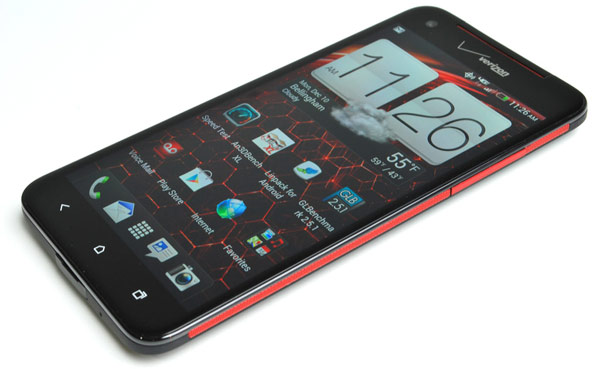There was a time when 5-inch and larger smartphones were scoffed at. The term "phablet" was coined and holding one of these things up to your head typically meant a bit of ridicule was in order. However, as devices got thinner, lighter and ever more sleek, the 5-inch smartphone has become a hot commodity with devices like the
Samsung Galaxy Note II taking off towards stratospheric
sales projections.
Recently HTC jumped in on the action with the launch of the Droid DNA for the Verizon network; offering a quad-core Snapdragon S4 SoC under the hood, the latest Android Jelly Bean operating system, an absolutely killer, gorgeous 5-inch IPS display with a full 1080p capable native resolution of 1200x1920 and out of the box wireless charging. Talk about hitting all the high points. Does this thing mix Margaritas too?
Let's give you a quick walk-around of the device and demo it in action. Then we'll look closer at the design, features and performance of this new smartphone titan.
 |
| HTC Droid DNA |
| Specifications & Features |
|
- Operating System: Android™ 4.1 (Jelly Bean) with HTC Sense™
- Processor: Qualcomm® APQ8064 Quad-core 1.5 GHz, MDM9615M
- Memory: 16 GB, 2 GB RAM
- Network: CDMA: 800/1900MHz; UMTS/HSPA: 850/900/1900/2100MHz; GSM/GPRS/EDGE: 850/900/1800/1900MHz; LTE 700 MHz (Band 13)
- Camera; 8 MP main camera with auto focus, LED Flash, BSI sensor, f/2.0 aperture, 28mm lens, 1080p HD video recording, w/ HTC ImageSense®: 2.1 MP front-facing camera, Dedicated HTC ImageChip®
- Keyboard/Form Factor: Virtual QWERTY
- Display: 5-inch super LCD3, HD 1080p, Gorilla® Glass 2
- Special Features: Beats Audio® built in, HTC ImageSense®, Dedicated HTC ImageChip®
- Battery: 2020 mAh LI-ION (embedded)
- Dimensions: 141 x 70.5 x 9.73 mm
- Weight: 140g / 4.94oz
The quad-core variant of Qualcomm's excellent Snapdragon S4 system-on-chip powers the DNA, along with an Adreno 320 graphics core that's backed by 2GB of system memory and 16GB of on-board storage. There's also an 8MP camera with LED flash, a 2.1MP front-facing cam and that sweet 5-inch super LCD3 IPS display we mentioned earlier with 1200x1920 resolution (440ppi). Other features include built-in Beats Audio which does add a bit of spatial openness, along with accentuated highs and lows but only if you're rocking headphones or buds. The small speaker on the back of the device is easily covered by your hand and, well, it's a tiny smartphone speaker so you can't expect much from it beyond speakerphone functionality.


The DNA brings along the familiar Verizon red and black color scheme which does accentuate the design nicely. The front is fairly clean with a single piece of Corning Gorilla glass. The capacitive Android navigation keys on the bottom don't consume screen real estate, thankfully. We can't say enough about how nice the DNA's display is. It's easily one of the nicest smartphone screens we've seen yet, with eye-popping brightness, great color saturation, good contrast and wide viewing angles. Pure and simple, it's five inches of love.


On the back you’ll see the DNA is entirely coated in a soft touch plastic which is a complete fingerprint and dust magnet but feels great in the hand. At 9.7mm thick, the DNA is thicker than many high-end smartphones these days but thanks to the tapered edges it has a deceivingly thin profile in your pocket or hand. What's baffling, however, is why HTC thought it made sense to cover the DNA's microUSB port with a plastic, tethered cap. You'll likely just want to rip the thing off as it just gets in the way, but to each his own we suppose.
One other design misstep is the location of the power button on the top, center of the device. It's often awkward to get to because the phone is so tall in the hand. I personally have larger-than-most hands and can deal with it. NFL Linebackers shouldn't have a problem getting to that button with one hand. Ladies, on the other hand (no pun intended), will have a long reach.
Android 4.1, otherwise known as Jelly Bean is here but it's lightly dressed in HTC's Sense 4+ user interface. This sort of a love it or hate it affair. In general, we like Sense 4+ but it's more of a departure from the pure Jelly Bean interface than TouchWiz is for some of the more recent Galaxy devices.


Occasionally, we found that it took another step or two to get things done with Sense 4+ but we did like the multitasking button on the front of the device that allows you to quickly cycle through recent apps with a tile interface, much like you'd see multiple web pages in tile view. That said, we did miss the app menu button which is replaced by this feature, leaving you with onscreen, in-app menu options to work with.













